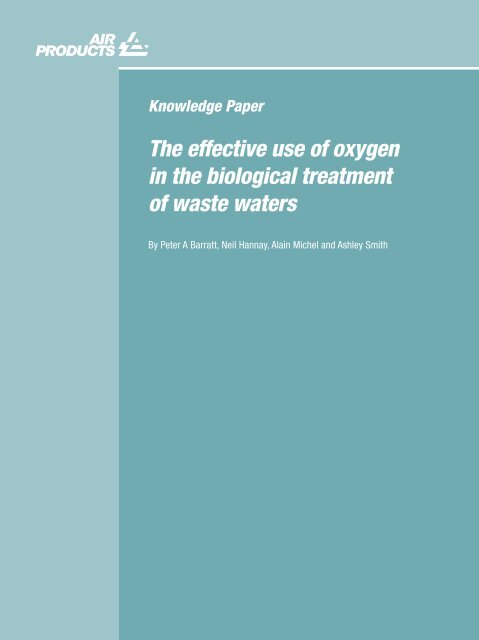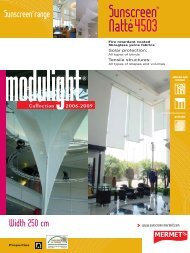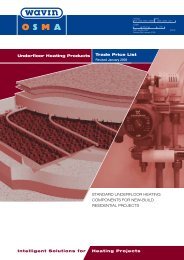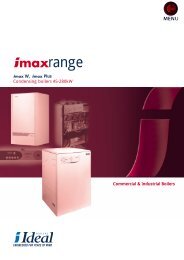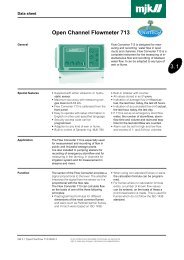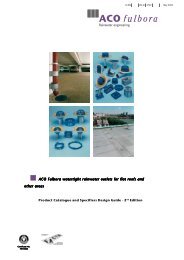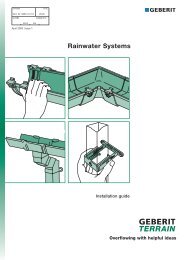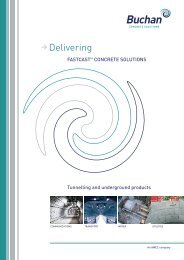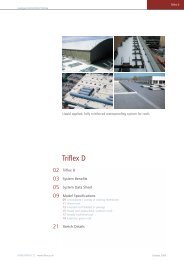The effective use of oxygen in the biological treatment of ... - CMS
The effective use of oxygen in the biological treatment of ... - CMS
The effective use of oxygen in the biological treatment of ... - CMS
You also want an ePaper? Increase the reach of your titles
YUMPU automatically turns print PDFs into web optimized ePapers that Google loves.
Knowledge Paper<br />
<strong>The</strong> <strong>effective</strong> <strong>use</strong> <strong>of</strong> <strong>oxygen</strong><br />
<strong>in</strong> <strong>the</strong> <strong>biological</strong> <strong>treatment</strong><br />
<strong>of</strong> waste waters<br />
By Peter A Barratt, Neil Hannay, Ala<strong>in</strong> Michel and Ashley Smith
Summary<br />
Oxygen has been widely <strong>use</strong>d dur<strong>in</strong>g <strong>the</strong> latter half <strong>of</strong> <strong>the</strong> twentieth century for <strong>the</strong><br />
<strong>biological</strong> <strong>treatment</strong> <strong>of</strong> waste waters, and yet its benefits compared with conventional<br />
aeration are not always fully understood. <strong>The</strong> keys to <strong>the</strong> efficient <strong>use</strong> <strong>of</strong> <strong>oxygen</strong> are:<br />
<strong>the</strong> design and operation <strong>of</strong> <strong>the</strong> waste water plant, <strong>the</strong> equipment <strong>use</strong>d to transfer<br />
gaseous <strong>oxygen</strong> to <strong>the</strong> liquid effluent <strong>in</strong> <strong>the</strong> <strong>treatment</strong> tank, and an <strong>in</strong>timate<br />
understand<strong>in</strong>g <strong>of</strong> <strong>the</strong> <strong>biological</strong> process, toge<strong>the</strong>r with prior knowledge <strong>of</strong> how <strong>the</strong><br />
biomass reacts to perturbations.<br />
© 1999 Air Products and Chemicals, Inc.<br />
All rights reserved. No part <strong>of</strong> this publication may be reproduced without <strong>the</strong> prior permission <strong>of</strong><br />
Air Products.
Clockwise from top left:<br />
Peter Barratt is responsible for Air Products’ global waste water <strong>treatment</strong><br />
technology portfolio. He has a degree <strong>in</strong> Microbiology, a PhD <strong>in</strong> Environmental<br />
Biochemistry, and has worked on effluent <strong>treatment</strong> for well over 10 years.<br />
Neil Hannay specialises <strong>in</strong> <strong>biological</strong> process eng<strong>in</strong>eer<strong>in</strong>g <strong>in</strong> Air Products’ European<br />
R&D group. Neil has a degree <strong>in</strong> <strong>the</strong> biosciences and process experience from a major<br />
UK water company, before jo<strong>in</strong><strong>in</strong>g Air Products <strong>in</strong> 1992.<br />
Ashley Smith (d. 2002), a Chartered Eng<strong>in</strong>eer and orig<strong>in</strong>al Eng<strong>in</strong>eer<strong>in</strong>g Design<br />
Owner for Oxy-Dep, helped develop Air Products’ <strong>biological</strong> waste water <strong>treatment</strong><br />
technology. Ashley was <strong>in</strong>volved <strong>in</strong> waste water <strong>treatment</strong> with <strong>oxygen</strong> for over<br />
15 years.<br />
Ala<strong>in</strong> Michel is a senior waste water <strong>treatment</strong> eng<strong>in</strong>eer <strong>in</strong> Air Products waste water<br />
team <strong>in</strong> France. Ala<strong>in</strong> has <strong>in</strong>stalled numerous Oxy-Dep systems <strong>in</strong> <strong>the</strong> field and has<br />
a wide experience <strong>in</strong> optimis<strong>in</strong>g <strong>biological</strong> <strong>treatment</strong> systems.
<strong>The</strong> <strong>effective</strong> <strong>use</strong> <strong>of</strong> <strong>oxygen</strong> <strong>in</strong> <strong>the</strong> <strong>biological</strong> <strong>treatment</strong><br />
<strong>of</strong> waste waters.<br />
<strong>The</strong> <strong>biological</strong> <strong>treatment</strong> <strong>of</strong> waste waters <strong>in</strong>cludes a vast array <strong>of</strong> <strong>treatment</strong> methods<br />
and equipment, developed over <strong>the</strong> years to treat a wide variety <strong>of</strong> wastes <strong>in</strong> <strong>the</strong> most<br />
<strong>effective</strong> way <strong>in</strong> order to reach <strong>the</strong> desired level <strong>of</strong> <strong>treatment</strong> for <strong>the</strong> waste before it is<br />
discharged.<br />
Aerobic <strong>biological</strong> <strong>treatment</strong><br />
Biological <strong>treatment</strong> methods requir<strong>in</strong>g <strong>oxygen</strong> (aerobic) can be broadly divided <strong>in</strong>to<br />
suspended growth and fixed film systems. Here, <strong>the</strong> active microorganisms<br />
undertak<strong>in</strong>g degradation <strong>of</strong> <strong>the</strong> waste are ei<strong>the</strong>r present as freely suspended particles<br />
<strong>in</strong> a stirred tank reactor (<strong>the</strong> activated sludge process), or as a <strong>biological</strong> film on a<br />
fixed surface. Examples <strong>of</strong> <strong>the</strong> latter <strong>in</strong>clude Rotat<strong>in</strong>g Biological Contactors (RBCs) or<br />
Trickl<strong>in</strong>g Filters.<br />
<strong>The</strong> <strong>use</strong> <strong>of</strong> pure <strong>oxygen</strong> for <strong>biological</strong> waste water <strong>treatment</strong> has largely, although not<br />
exclusively, been <strong>use</strong>d for suspended growth processes, notably activated sludge; but<br />
why have waste water <strong>treatment</strong> plant operators decided to <strong>use</strong> <strong>oxygen</strong> as opposed<br />
to air to achieve <strong>the</strong> desired results?<br />
High Purity Oxygen versus Air<br />
<strong>The</strong>re are a number <strong>of</strong> recognised advantages <strong>of</strong> us<strong>in</strong>g <strong>oxygen</strong> <strong>in</strong> <strong>the</strong> activated sludge<br />
process, most <strong>of</strong> which are listed <strong>in</strong> Table 1, but do <strong>the</strong>se always hold true, and why?<br />
<strong>The</strong>re are some properties <strong>of</strong> <strong>oxygen</strong>, whe<strong>the</strong>r supplied as high purity liquid <strong>oxygen</strong> or<br />
as on-site produced <strong>oxygen</strong> (usually at purities
1. Oxygen transfer rate<br />
Solubility<br />
High purity <strong>oxygen</strong> achieves faster <strong>oxygen</strong> mass transfer rates <strong>in</strong>to water than air.<br />
This is due to physico-chemical facts concern<strong>in</strong>g <strong>the</strong> <strong>in</strong>teraction <strong>of</strong> gases and liquids.<br />
Henry’s Law says that <strong>the</strong> concentration <strong>of</strong> a gas dissolved <strong>in</strong> a liquid <strong>in</strong>creases with<br />
<strong>the</strong> pressure <strong>of</strong> <strong>the</strong> gas phase. At a given absolute pressure, <strong>the</strong> solubility <strong>of</strong> an<br />
<strong>in</strong>dividual gas will <strong>in</strong>crease with <strong>in</strong>creas<strong>in</strong>g concentration (partial pressure) <strong>of</strong> that<br />
gas; thus for waste water:<br />
equation 1 …….[O 2 ] (aq) = H. [O 2 ] (g)<br />
where [O 2 ] (aq) is <strong>the</strong> <strong>oxygen</strong> concentration <strong>in</strong> <strong>the</strong> effluent, [O 2 ] (g) is <strong>the</strong> <strong>oxygen</strong><br />
concentration <strong>in</strong> <strong>the</strong> gas phase, and H is Henry’s constant, which is both specific to<br />
<strong>the</strong> gas concerned and highly dependent upon temperature.<br />
<strong>The</strong> saturation concentration <strong>of</strong> pure <strong>oxygen</strong> <strong>in</strong> water is 39.3mg/l at 25°C and 1<br />
atmosphere, but accord<strong>in</strong>g to <strong>the</strong> equation above this maximum solubility under <strong>the</strong><br />
stated conditions will decrease with decreas<strong>in</strong>g <strong>oxygen</strong> concentration <strong>in</strong> <strong>the</strong> gas<br />
phase. So, <strong>in</strong> air (21% <strong>oxygen</strong> by volume), maximum <strong>oxygen</strong> solubility becomes<br />
8.25mg/l.<br />
<strong>The</strong> difference between 39.3 and 8.25 is <strong>the</strong> fundamental reason why <strong>oxygen</strong> transfer<br />
from gas to liquid is faster for pure <strong>oxygen</strong> than for air. <strong>The</strong>se maximum solubilities<br />
heavily <strong>in</strong>fluence <strong>the</strong> driv<strong>in</strong>g force for <strong>oxygen</strong> transfer rate <strong>in</strong>to liquid. In just <strong>the</strong> same<br />
way, carbon dioxide, with a relatively high aqueous solubility (H = 1450mg/l/atm @<br />
25°C) can be dissolved at a faster rate than <strong>oxygen</strong>.<br />
Mass transfer rate<br />
So, how does greater <strong>oxygen</strong> solubility help mass transfer <strong>in</strong> an activated sludge<br />
process? Oxygen is <strong>of</strong> little or no <strong>use</strong> to a microorganism unless it is first dissolved <strong>in</strong><br />
water. <strong>The</strong> rate at which a gas passes from <strong>the</strong> gas phase <strong>in</strong>to <strong>the</strong> liquid phase <strong>of</strong> an<br />
activated sludge process is dictated by <strong>the</strong> follow<strong>in</strong>g:
equation 2……dM/dt = k L a (C S - C AS )<br />
where, dM/dt is <strong>the</strong> rate <strong>of</strong> gas mass transfer, k L is <strong>the</strong> liquid side gas mass transfer<br />
coefficient, a is <strong>the</strong> <strong>in</strong>terfacial surface area <strong>of</strong> <strong>the</strong> gas bubbles, C S is <strong>the</strong> maximum<br />
solubility <strong>of</strong> <strong>the</strong> gas <strong>in</strong> <strong>the</strong> liquid (activated sludge liquors), and C AS <strong>the</strong> actual<br />
concentration <strong>of</strong> <strong>the</strong> gas <strong>in</strong> <strong>the</strong> activated sludge liquors (measured as dissolved<br />
<strong>oxygen</strong>)<br />
Whilst <strong>oxygen</strong> can provide higher dissolved <strong>oxygen</strong> concentrations <strong>in</strong> <strong>the</strong> mixed<br />
liquors than can air, <strong>the</strong>re is no advantage <strong>in</strong> this alone (1) . <strong>The</strong> important fact is that,<br />
with C AS stay<strong>in</strong>g <strong>the</strong> same whe<strong>the</strong>r for air or <strong>oxygen</strong> (<strong>of</strong>ten <strong>in</strong> <strong>the</strong> range 1-4mg/l<br />
dissolved <strong>oxygen</strong>), <strong>the</strong> C S - C AS term above is much larger for <strong>oxygen</strong> than for air, and<br />
this has a marked effect on <strong>in</strong>creas<strong>in</strong>g <strong>the</strong> rate <strong>of</strong> <strong>oxygen</strong> transfer.<br />
1 Faster rates <strong>of</strong> <strong>oxygen</strong> transfer<br />
2 Smaller activated sludge reactor size<br />
3 Greater flexibility for load<strong>in</strong>g fluctuations<br />
4 Lower emissions to atmosphere<br />
5 Rapid response to shock loads<br />
6 Low capital option for exist<strong>in</strong>g plant expansion<br />
7 Improved sludge quality<br />
8 Low mechanical wear<br />
9 Low noise<br />
10 Fast emergency response<br />
Table 1: Commonly cited advantages <strong>of</strong> <strong>oxygen</strong> compared with air for <strong>the</strong> aerobic <strong>biological</strong><br />
<strong>treatment</strong> <strong>of</strong> waste waters.<br />
Bubble size<br />
Equation 2 also implies that if <strong>oxygen</strong> passes <strong>in</strong>to <strong>the</strong> waste water <strong>in</strong> <strong>the</strong> form <strong>of</strong><br />
many very f<strong>in</strong>e bubbles as opposed to a fewer number <strong>of</strong> large bubbles, <strong>the</strong>n, due to<br />
<strong>the</strong> high surface area <strong>of</strong> <strong>oxygen</strong> bubbles <strong>in</strong> contact with <strong>the</strong> water <strong>the</strong> term a will be<br />
much higher. Thus <strong>the</strong> rate <strong>of</strong> mass transfer will be even higher still. For this reason<br />
devices which are <strong>use</strong>d to dissolve <strong>oxygen</strong> efficiently <strong>in</strong> activated sludge plants<br />
usually aim to produce f<strong>in</strong>e bubbles. Air Products Oxy-Dep processes <strong>use</strong> equipment
which does this very <strong>effective</strong>ly, although <strong>the</strong>re are a number <strong>of</strong> devices which<br />
attempt to do <strong>the</strong> same th<strong>in</strong>g <strong>in</strong> different ways.<br />
<strong>The</strong> follow<strong>in</strong>g are some examples <strong>of</strong> devices <strong>use</strong>d for <strong>the</strong> application <strong>of</strong> <strong>oxygen</strong> to <strong>the</strong><br />
activated sludge process.<br />
Oxygen Dissolution Devices<br />
Bubble diff<strong>use</strong>rs<br />
Gas is usually <strong>in</strong>troduced <strong>in</strong>to a liquid phase reaction as bubbles. This is <strong>the</strong> case for<br />
most <strong>oxygen</strong> activated sludge processes. Bubble size has an effect on <strong>the</strong> rate at<br />
which <strong>oxygen</strong> passes <strong>in</strong>to <strong>the</strong> liquid phase, and it is here that it can <strong>the</strong>n be <strong>use</strong>d <strong>in</strong><br />
<strong>in</strong>tracellular and extracellular <strong>biological</strong> processes requir<strong>in</strong>g <strong>oxygen</strong>. Bubble diff<strong>use</strong>rs<br />
assist <strong>in</strong> <strong>the</strong> formation <strong>of</strong> a mass <strong>of</strong> <strong>oxygen</strong> bubbles with<strong>in</strong> a given size range, by<br />
push<strong>in</strong>g <strong>the</strong> gas, under pressure, through a solid medium perforated by pores. <strong>The</strong><br />
bubble size range is dependent upon <strong>the</strong> size <strong>of</strong> <strong>the</strong> pores through which <strong>the</strong> gas<br />
passes. In this way systems are <strong>of</strong>ten referred to as ei<strong>the</strong>r coarse or f<strong>in</strong>e bubble<br />
diff<strong>use</strong>rs.<br />
<strong>The</strong> medium <strong>use</strong>d for <strong>the</strong> diff<strong>use</strong>r can be made <strong>of</strong> plastic (flexible or rigid) or ceramic<br />
materials, and is usually <strong>in</strong>stalled on <strong>the</strong> bottom <strong>of</strong> <strong>the</strong> activated sludge reactor.<br />
Bubbles formed at <strong>the</strong> surface <strong>of</strong> <strong>the</strong> diff<strong>use</strong>r rise through <strong>the</strong> tank and <strong>oxygen</strong><br />
transfer takes place at <strong>the</strong> bubble surface. In this way gentle mix<strong>in</strong>g <strong>of</strong> <strong>the</strong> mixed<br />
liquors <strong>in</strong> <strong>the</strong> tank takes place. Additional mix<strong>in</strong>g may be required to keep <strong>the</strong><br />
biomass suspended. Additional mix<strong>in</strong>g, and <strong>the</strong>refore power, can be added via low<br />
energy turb<strong>in</strong>e-type mixers.<br />
In-pipe <strong>in</strong>jection<br />
Some simple <strong>oxygen</strong> <strong>biological</strong> <strong>treatment</strong> <strong>in</strong>stallations <strong>use</strong> direct <strong>in</strong>jection <strong>of</strong> <strong>oxygen</strong><br />
<strong>in</strong>to a mov<strong>in</strong>g liquid effluent stream with<strong>in</strong> a pipe. <strong>The</strong> flow <strong>of</strong> liquid, if fast enough,<br />
breaks up <strong>the</strong> <strong>in</strong>com<strong>in</strong>g gas <strong>in</strong>to bubbles and gives rise to a two-phase gas-<strong>in</strong>-liquid<br />
flow regime along <strong>the</strong> pipe. At <strong>the</strong> end <strong>of</strong> <strong>the</strong> pipe <strong>the</strong> two-phase flow exits <strong>in</strong>to <strong>the</strong><br />
<strong>treatment</strong> tank, where <strong>the</strong> bubbles have additional residence time for <strong>the</strong> <strong>oxygen</strong> to<br />
dissolve <strong>in</strong> <strong>the</strong> liquid phase.
One classical <strong>use</strong> <strong>of</strong> this <strong>in</strong>jection mode has been <strong>in</strong> <strong>the</strong> <strong>use</strong> <strong>of</strong> <strong>oxygen</strong> with<strong>in</strong> ris<strong>in</strong>g<br />
sewage ma<strong>in</strong>s, <strong>in</strong> order to avoid odours e.g. hydrogen sulphide formation, and<br />
corrosion <strong>in</strong> <strong>the</strong> ma<strong>in</strong>s (2) .<br />
Float<strong>in</strong>g mixers<br />
<strong>The</strong>re are a variety <strong>of</strong> <strong>oxygen</strong>ation devices which broadly <strong>use</strong> <strong>the</strong> approach <strong>of</strong> surface<br />
aerators. <strong>The</strong>y float on <strong>the</strong> surface <strong>of</strong> <strong>the</strong> activated sludge liquors, and <strong>oxygen</strong> is<br />
<strong>in</strong>troduced near <strong>the</strong> liquid-gas <strong>in</strong>terface. At <strong>the</strong> <strong>in</strong>terface <strong>the</strong> <strong>oxygen</strong> is drawn down<br />
<strong>in</strong>to <strong>the</strong> mixed liquors, <strong>of</strong>ten through a submerged impeller-like device, where it forms<br />
bubbles and performs some mix<strong>in</strong>g (3) .<br />
<strong>The</strong>se devices, whilst easy to <strong>in</strong>stall, may require anchor<strong>in</strong>g to <strong>the</strong> sides <strong>of</strong> <strong>the</strong> bas<strong>in</strong>,<br />
and perform only localised mix<strong>in</strong>g <strong>in</strong> <strong>the</strong> tank. Vertical passage <strong>of</strong> <strong>the</strong> <strong>oxygen</strong> bubbles<br />
may also be limited such that <strong>the</strong> bottom <strong>of</strong> deeper bas<strong>in</strong>s may not be well mixed,<br />
and <strong>oxygen</strong> bubbles have less residence time as <strong>the</strong>y rise to <strong>the</strong> surface.<br />
Air Products’ Oxy-Dep process equipment, whilst us<strong>in</strong>g a different means <strong>of</strong> f<strong>in</strong>e<br />
bubble formation and mix<strong>in</strong>g, has been adapted to float<strong>in</strong>g operation, especially <strong>in</strong><br />
large activated sludge lagoons, such as those <strong>use</strong>d <strong>in</strong> <strong>the</strong> pulp and paper <strong>in</strong>dustry (4) .<br />
Sidestream <strong>in</strong>jection (Oxy-Dep )<br />
In most parts <strong>of</strong> <strong>the</strong> world where <strong>oxygen</strong> is <strong>use</strong>d <strong>in</strong> activated sludge plants to<br />
accomodate BOD and COD load<strong>in</strong>g rates, <strong>oxygen</strong> is added via a sidestream <strong>in</strong>jection<br />
system. <strong>The</strong> Oxy-Dep process <strong>use</strong>s an advanced type <strong>of</strong> sidestream <strong>in</strong>jector to<br />
deliver <strong>oxygen</strong> <strong>in</strong> <strong>the</strong> form <strong>of</strong> very f<strong>in</strong>e bubbles to an activated sludge process.<br />
Broadly, <strong>the</strong>re are two types <strong>of</strong> Oxy-Dep <strong>in</strong>stallation but both <strong>use</strong> <strong>the</strong> sidestream<br />
system; <strong>the</strong>se are skid-mounted systems and fixed <strong>in</strong>stallations.<br />
Skid-mounted Oxy-Dep <br />
Figure 1 shows an Oxy-Dep skid designed to deliver 100kgO 2 /h <strong>in</strong>to <strong>the</strong> process.<br />
<strong>The</strong> device is simple <strong>in</strong> operation, robust <strong>in</strong> structure and <strong>the</strong> effects are quite<br />
dramatic. <strong>The</strong> Oxy-Dep skid is lowered <strong>in</strong>to <strong>the</strong> activated sludge bas<strong>in</strong> and rests on<br />
<strong>the</strong> bottom. Oxy-Dep skids have been adapted to rest on purpose built pl<strong>in</strong>ths where
<strong>the</strong> bottom <strong>of</strong> a bas<strong>in</strong> may be sensitive to damage e.g. a membrane-l<strong>in</strong>ed lagoon.<br />
Once <strong>in</strong>stalled, with power to <strong>the</strong> submersible pump and an <strong>oxygen</strong> l<strong>in</strong>e from <strong>the</strong><br />
<strong>oxygen</strong> source, mixed liquors from <strong>the</strong> bas<strong>in</strong> are pumped <strong>in</strong>to <strong>the</strong> “sidestream”<br />
through <strong>the</strong> centrifugal pump and through a specially designed venturi. At <strong>the</strong> throat<br />
<strong>of</strong> <strong>the</strong> venturi, <strong>oxygen</strong> gas is pushed <strong>in</strong>to <strong>the</strong> vane <strong>of</strong> liquid pass<strong>in</strong>g through <strong>the</strong><br />
venturi constriction and <strong>oxygen</strong> is transferred <strong>in</strong>to <strong>the</strong> mov<strong>in</strong>g liquid stream. <strong>The</strong><br />
liquid-gas mixture is <strong>the</strong>n returned to <strong>the</strong> bulk mixed liquors via a manifold with a<br />
number <strong>of</strong> nozzles. <strong>The</strong> pressure drop across <strong>the</strong> nozzles assists fur<strong>the</strong>r <strong>in</strong> break<strong>in</strong>g<br />
up <strong>the</strong> large number <strong>of</strong> <strong>oxygen</strong> bubbles <strong>in</strong>to an even larger number <strong>of</strong> micro bubbles.<br />
<strong>The</strong>se bubbles are ejected <strong>in</strong>to <strong>the</strong> bas<strong>in</strong> through a secondary ejector at <strong>the</strong> end <strong>of</strong><br />
each nozzle, which helps to direct liquid-liquid mix<strong>in</strong>g just after <strong>the</strong> nozzle, <strong>the</strong>reby<br />
dissipat<strong>in</strong>g <strong>oxygen</strong> whilst optimis<strong>in</strong>g mix<strong>in</strong>g energy requirements <strong>in</strong> <strong>the</strong> bulk<br />
mixed liquors.<br />
Fixed Oxy-Dep <br />
In fixed Oxy-Dep <strong>in</strong>stallations an externally mounted pump is <strong>use</strong>d <strong>in</strong>stead <strong>of</strong> a<br />
submerged type. O<strong>the</strong>rwise <strong>the</strong> design criteria are <strong>the</strong> same. Compared with <strong>the</strong> skidmounted<br />
Oxy-Dep , <strong>the</strong> external pumps are easier to service, and <strong>the</strong>re is more<br />
flexibility over where <strong>the</strong> nozzles can be positioned <strong>in</strong> <strong>the</strong> bas<strong>in</strong>. Often, whereas skids<br />
have been <strong>use</strong>d to retr<strong>of</strong>it exist<strong>in</strong>g air activated sludge bas<strong>in</strong>s, fixed <strong>in</strong>stallations are<br />
usually <strong>in</strong>stalled where a new plant is be<strong>in</strong>g built, or where a permanent <strong>oxygen</strong><br />
system is required.<br />
Oxy-Dep VSA<br />
A unique <strong>oxygen</strong>ation system <strong>in</strong>corporat<strong>in</strong>g simple on-site <strong>oxygen</strong> generation <strong>in</strong><br />
small, modular units each deliver<strong>in</strong>g from 260 to 875 kgO 2 /day, and submerged lowenergy<br />
propellor mixers. Air Products’ novel s<strong>in</strong>gle valve, s<strong>in</strong>gle separation bed<br />
technology for air-<strong>oxygen</strong> separation delivers <strong>the</strong> process benefits <strong>of</strong> <strong>oxygen</strong> at <strong>the</strong><br />
cost <strong>of</strong> aeration. An Oxy-Dep VSA package can be <strong>in</strong>stalled with<strong>in</strong> two hours on<br />
site, and requires only a power supply.
Figure 1: A skid-mounted Oxy-Dep unit
Performance<br />
Amongst plant operators <strong>the</strong>re are some commonly asked questions regard<strong>in</strong>g <strong>the</strong><br />
<strong>use</strong> <strong>of</strong> high purity <strong>oxygen</strong> and Oxy-Dep for activated sludge waste water <strong>treatment</strong>,<br />
especially where air has been <strong>use</strong>d as <strong>the</strong> sole source <strong>of</strong> <strong>oxygen</strong> before. Some <strong>of</strong><br />
<strong>the</strong>se questions, and <strong>the</strong> answers, are as follows.<br />
Will mix<strong>in</strong>g be as good?<br />
Yes. Oxy-Dep processes are designed to impart generous mix<strong>in</strong>g to <strong>the</strong> activated<br />
sludge bas<strong>in</strong> at reasonable power consumption. <strong>The</strong> more homogeneous mix <strong>of</strong> gas<br />
bubbles <strong>in</strong> <strong>the</strong> activated sludge, and <strong>the</strong> mix<strong>in</strong>g provided by <strong>the</strong> pump at <strong>the</strong> nozzles<br />
ensures more even and controlled mix<strong>in</strong>g than <strong>in</strong> many air-fed systems.<br />
Figure 2 shows output from a Computational Fluid Dynamics model, designed by Air<br />
Products us<strong>in</strong>g Fluent s<strong>of</strong>tware. It illustrates <strong>the</strong> modell<strong>in</strong>g <strong>of</strong> a typical waste water<br />
<strong>treatment</strong> bas<strong>in</strong> conta<strong>in</strong><strong>in</strong>g an Oxy-Dep skid, and shows a liquid velocity contour<br />
map through <strong>the</strong> bas<strong>in</strong>. This type <strong>of</strong> model can be run for any waste water <strong>treatment</strong><br />
bas<strong>in</strong>, even large lagoons, with uneven base and sides, and <strong>the</strong> position <strong>of</strong> <strong>the</strong><br />
nozzles altered to optimise <strong>the</strong> velocity pr<strong>of</strong>ile <strong>of</strong> <strong>the</strong> bas<strong>in</strong>, and so reduce <strong>the</strong><br />
opportunity for areas with poor mix<strong>in</strong>g to occur.<br />
Scale, m/s Without Baffle<br />
Figure 2: CFD velocity pr<strong>of</strong>ile <strong>of</strong> an activated sludge reactor show<strong>in</strong>g <strong>the</strong> pr<strong>of</strong>ile <strong>of</strong> liquid<br />
movement.
How efficient is <strong>the</strong> <strong>oxygen</strong> transfer?<br />
Good provided certa<strong>in</strong> key criteria are met. In an ideal situation 100% <strong>of</strong> <strong>the</strong> <strong>oxygen</strong><br />
delivered <strong>in</strong>to <strong>the</strong> activated sludge will be <strong>use</strong>d by <strong>the</strong> biomass, and none will escape<br />
at <strong>the</strong> surface. More usually, <strong>in</strong> an optimised process, Oxygen Transfer Efficiency<br />
(OTE) should be >90%. However, <strong>in</strong> order to approach 100% OTE <strong>the</strong> follow<strong>in</strong>g are<br />
required:<br />
• equipment produc<strong>in</strong>g f<strong>in</strong>e bubbles and good mix<strong>in</strong>g<br />
• >3m depth above <strong>the</strong> po<strong>in</strong>t where <strong>oxygen</strong> is <strong>in</strong>troduced<br />
• a high concentration <strong>of</strong> active aerobic biomass<br />
• adequate residence time<br />
• α and β factors (6) approach<strong>in</strong>g unity.<br />
<strong>The</strong>se criteria amongst o<strong>the</strong>rs suggest that <strong>the</strong> only accurate way to assess OTE is by<br />
direct measurement. Estimates can be made by measur<strong>in</strong>g COD removed across <strong>the</strong><br />
plant and <strong>oxygen</strong> delivered, over a def<strong>in</strong>ed period <strong>of</strong> time. However, <strong>in</strong> an established<br />
activated sludge, nei<strong>the</strong>r COD nor BOD are likely to be removed <strong>in</strong> a 1:1 ratio with<br />
<strong>oxygen</strong>. Oxygen mass balance across <strong>the</strong> plant, us<strong>in</strong>g <strong>of</strong>f-gas analysis <strong>of</strong> <strong>oxygen</strong> at<br />
<strong>the</strong> surface, has been <strong>use</strong>d to give an estimate <strong>of</strong> OTE (5) , although this is not easy to<br />
measure accurately.<br />
How will solids management be affected?<br />
Oxygen can show benefits. Whilst, <strong>in</strong> a conventional gravity sludge settlement system,<br />
clarifier size limits hydraulic flow and sludge recycle <strong>in</strong> a highly loaded plant, <strong>oxygen</strong><br />
has been shown to assist sludge management. In many cases <strong>oxygen</strong> will improve<br />
<strong>biological</strong> floc formation <strong>in</strong> a heavily loaded plant, by mak<strong>in</strong>g <strong>oxygen</strong> freely available<br />
to each floc. Smaller, denser flocs <strong>in</strong> Oxy-Dep processes <strong>of</strong>ten show enhanced<br />
dewater<strong>in</strong>g, and lower waste sludge solids. At a site us<strong>in</strong>g <strong>the</strong> Oxy-Dep process to<br />
digest sludge, field trials showed that <strong>the</strong> digested sludge was dewatered to 24%<br />
solids as opposed to 16% solids for a parallel aerated sludge digester, us<strong>in</strong>g <strong>the</strong> same<br />
dewater<strong>in</strong>g device.<br />
Oxygen has also been shown to assist <strong>in</strong> avoid<strong>in</strong>g <strong>the</strong> development <strong>of</strong> filamentous<br />
bulk<strong>in</strong>g (due to filamentous bacteria) <strong>in</strong> activated sludge (2) .
What is <strong>the</strong> real benefit <strong>of</strong> <strong>oxygen</strong> over air?<br />
Table 1 highlighted <strong>the</strong> recognised benefits <strong>of</strong> <strong>oxygen</strong> activated sludge over<br />
conventional aeration. Today, <strong>the</strong> high efficiency <strong>of</strong> gas generation and gas-to-liquid<br />
transfer equipment means <strong>oxygen</strong>ation runn<strong>in</strong>g costs do compete with air, but <strong>the</strong><br />
real benefits <strong>of</strong> <strong>oxygen</strong> lie <strong>in</strong> <strong>the</strong> rapid and susta<strong>in</strong>able process acclimatisation which<br />
<strong>oxygen</strong> <strong>of</strong>fers for effluents which are <strong>in</strong>consistent both <strong>in</strong> load and <strong>in</strong> <strong>the</strong>ir chemistry.<br />
Aside from <strong>the</strong> process advantages <strong>of</strong> <strong>oxygen</strong> activated sludge processes, and <strong>the</strong><br />
added comfort for plant operators that this gives compared with aerated systems,<br />
runn<strong>in</strong>g costs for <strong>oxygen</strong> are not high. Aeration runn<strong>in</strong>g costs comprise <strong>the</strong> power<br />
applied to run blowers, surface aerator motors etc, whereas <strong>oxygen</strong> costs comprise<br />
<strong>the</strong> cost <strong>of</strong> <strong>the</strong> gas plus <strong>the</strong> power <strong>use</strong>d by <strong>the</strong> dissolution device i.e. liquid pump<strong>in</strong>g<br />
for Oxy-Dep . Oxygen costs vary accord<strong>in</strong>g to geographical availability and mode <strong>of</strong><br />
supply, but power costs for <strong>oxygen</strong>ation are uniformly low.<br />
<strong>The</strong> Oxy-Dep process <strong>use</strong>s approximately 1kWh to transfer 5-6kgO . Aerators,<br />
2<br />
(5) depend<strong>in</strong>g on type, <strong>use</strong> 1kWh to transfer 0.7 - 1.5kgO and Oxy-Dep VSA<br />
2<br />
transfers <strong>oxygen</strong> at a specific power well with<strong>in</strong> this range.<br />
If I <strong>use</strong> <strong>oxygen</strong>, where should I get it from?<br />
As a gas and process provider, Air Products produces its <strong>in</strong>dustrial gases <strong>in</strong> <strong>the</strong> most<br />
economic way, and allies <strong>the</strong>m with <strong>the</strong> most <strong>effective</strong> process equipment, and<br />
process know-how. In this way Oxy-Dep processes may <strong>use</strong> liquid <strong>oxygen</strong> as <strong>the</strong><br />
gas supply, or gaseous <strong>oxygen</strong> from one <strong>of</strong> a number <strong>of</strong> lower pressure gaseous<br />
sources. <strong>The</strong> latter is likely to be a Vacuum Sw<strong>in</strong>g Absorption (VSA) process, where<br />
<strong>oxygen</strong> and nitrogen from <strong>the</strong> air are separated by chang<strong>in</strong>g <strong>the</strong> pressures <strong>in</strong> a vessel<br />
conta<strong>in</strong><strong>in</strong>g an adsorbent medium with different selectivities for <strong>the</strong> two gases. Oxy-<br />
Dep VSA makes full <strong>use</strong> <strong>of</strong> this technology.<br />
Process equipment differs depend<strong>in</strong>g on <strong>the</strong> site, <strong>the</strong> <strong>oxygen</strong> source and <strong>the</strong> process<br />
requirements, and this comb<strong>in</strong>ation will dictate <strong>the</strong> most <strong>effective</strong> solution.
<strong>The</strong> future <strong>of</strong> <strong>oxygen</strong>-based processes<br />
Oxygen processes for <strong>the</strong> <strong>biological</strong> <strong>treatment</strong> <strong>of</strong> waste water are established<br />
technology, with recognised benefits, but current Oxy-Dep processes are not <strong>the</strong><br />
f<strong>in</strong>al word. Air Products cont<strong>in</strong>ues to make advances <strong>in</strong> <strong>the</strong> field by improv<strong>in</strong>g <strong>oxygen</strong><br />
generation equipment performance, <strong>in</strong>creas<strong>in</strong>g plant performance through <strong>biological</strong><br />
process understand<strong>in</strong>g and optimised equipment, and push<strong>in</strong>g <strong>in</strong>to completely new<br />
technologies for <strong>the</strong> <strong>effective</strong> <strong>biological</strong> <strong>treatment</strong> <strong>of</strong> waste waters and sludges. Some<br />
<strong>of</strong> <strong>the</strong> references Air Products now have demonstrate <strong>the</strong> <strong>biological</strong> <strong>treatment</strong> <strong>of</strong><br />
waste waters never before considered treatable by <strong>the</strong>se means, and at load<strong>in</strong>g rates<br />
hi<strong>the</strong>rto unknown.<br />
References<br />
1. G F G Clough. Wastewater Treatment. 1979. In Developments <strong>in</strong> Environmental<br />
Control and Public Health - 1. Editor A Porteous. pp1-28.<br />
2. A G Boon, C F Skellett, S Newcombe, J G Jones and C F Forster. 1977. <strong>The</strong> Use <strong>of</strong><br />
Oxygen to Treat Sewage <strong>in</strong> a Ris<strong>in</strong>g Ma<strong>in</strong>. Water Pollution Control, Vol. 76. 98-112.<br />
3. T A Badar. 1986. Oxygen <strong>in</strong>jection - an alternative effluent <strong>treatment</strong>. Tappi<br />
Journal, Vol 69, No. 10. October 1986. 82-85.<br />
4. J P<strong>in</strong>to and R Leite. Yield <strong>in</strong>crease, control and automation <strong>of</strong> <strong>biological</strong> waste<br />
water <strong>treatment</strong> stations by <strong>the</strong> <strong>oxygen</strong> uptake rate method. In Press.<br />
5. G T Daigger and J A Buttz. 1998. Upgrad<strong>in</strong>g Wastewater Treatment Plants. Water<br />
Quality Management Library, Vol. 2. Technomic Publish<strong>in</strong>g Co. Inc. 243 pages.<br />
6. G Tchobanoglous and F L Burton. 1991. Wastewater Eng<strong>in</strong>eer<strong>in</strong>g - Treatment,<br />
Disposal and Re<strong>use</strong>. McGraw-Hill, Inc. Third edition. p286.<br />
7. Air Products case study RSAG. Available from Air Products.<br />
8. P Rüütel, S-Y Lee, P Barratt and V White. 1998. Efficient <strong>use</strong> <strong>of</strong> Ozone with <strong>the</strong><br />
Chemox -SR reactor. Air Products Knowledge Paper No. 2.<br />
Available from Air Products.
tell me more<br />
www.airproducts.com<br />
Air Products PLC, Hersham Place, Molesey Road, Walton-on-Thames, Surrey KT12 4RZ<br />
Tel 0800 3890202 e-mail <strong>in</strong>fo@apci.com<br />
© Air Products and Chemicals Inc. 2003 240-03-004-UK


